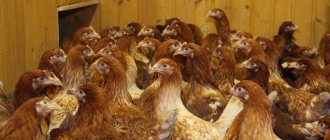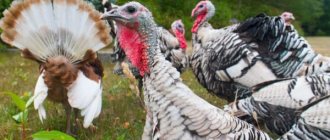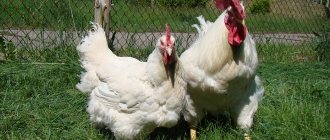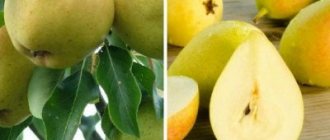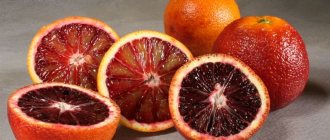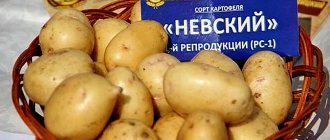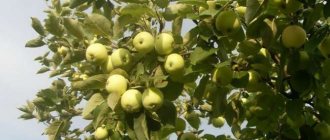German Loman Brown chickens are one of the best among egg crosses. They are used in industrial poultry farming and in private farmsteads.
Laying hens are hardy and easily adapt to different climatic conditions, but their main advantage is their high productivity.
The birds provide the owner with a large number of large eggs weighing 63 g. Farmers interested in raising hybrid chickens first need to learn more about their features, advantages and disadvantages.
Origin story
The Loman Brown breed is the creation of breeders from Germany. It was developed by Lohmann Tierzucht Gmb based on four hybrid lines.
Scientists have set themselves the goal of obtaining a hardy, highly productive egg-laying bird that is easy to care for. There were no requirements for the appearance of the laying hens.
The created hybrid fully met the breeders' expectations and even exceeded them.
Chickens of the Loman Brown breed are distinguished by high vitality, undemanding conditions of keeping, cold resistance and high egg productivity.
Moreover, they are autosex - the sex of the chicks can be determined from the moment of birth by the color of the down. In hens it is light brown, and in cockerels it is yellow.
Varieties
There are two varieties of this cross:
Loman brown classic
This type is most common in both Europe and Russia. It is characterized by unpretentiousness in nutrition, as well as in maintenance. The birds have brown plumage.
Their body is set straight and quite high. Hens have a white “necklace” stripe near the neck.
Loman brown white
This type has white feathers. Laying hens are smaller in size than the classic type. This further reduces feeding costs. Breeders note the excellent character of this type.
Chickens are obedient, not shy, and tolerate various changes in the conditions of their keeping.
Among the features of the type is a clear difference between males and females immediately after hatching. Roosters are bright white, and hens are fawn in color.
Description of the breed
Photo:
The appearance of the birds is unremarkable. Laying hens have a body structure typical of egg-laying hens. Their weight is small - 1.6–2 kg. The plumage is made in brown tones, shiny, soft to the touch.
Roosters are slightly larger - 2.7–3 kg. Feather color is white or beige with rare splashes of red-brown.
Characteristic:
- compact head with a leaf-shaped red comb crowning it;
- earrings are round, small;
- face and earlobes are red;
- orange eyes;
- barrel-shaped body;
- the chest is weakly muscled;
- voluminous belly;
- the neck is long;
- the wings are well developed;
- metatarsus yellow, bare;
- The short tail is sparse, raised 90 degrees.
Temperament
Farmers who have experience keeping chickens from the German company Lohmann Tierzucht leave positive reviews about them. These are calm birds that do not require complex care.
They quickly adapt to a new place, are not afraid of the cold, and do not conflict with each other. Feeding is not a problem with birds - they willingly eat feed without sorting through it.
Productivity
Loman Brown laying hens mature at the age of 145–150 days. When kept in cages, their productivity turns out to be higher than when kept in a yard, and amounts to 315–320 eggs per year.
Shell color is brown. Peak egg production occurs at 26–30 weeks. Product weight – 63–65 g. A mature chicken weighs approximately 1 kg 700 g.
Attention! Brown laying hens are 5–6 g ahead of Leghorns in egg weight.
The meat of egg-laying chickens is of low quality - it is dry and fibrous. The chest, thighs and legs are poorly developed. However, the carcasses of young roosters can be used to prepare broth.
Description of Loman Brown chickens
The breed, or rather a four-line cross, belongs to the egg production direction. Therefore, birds do not gain large live weight, but have a strong, well-built body with a wide chest and well-developed wings. The leaf-shaped comb and earrings are bright red. The earlobes of roosters are red with a pearly white center, while those of chickens are oval, dark pink with a red edging along the edge. The feet are of medium length, yellow, with brown scales at the end of the metatarsus and toes. The plumage is dense and smooth, light brown, sometimes with a reddish tint, dark feathers in the tail and on the wings, and a white “collar” on the neck.
Day-old male and female chicks are distinguished by the color of their down.
Browns are autosex, that is, the sex of the chicks can be determined already in the first day after hatching: the cockerels are yellow-white, the hens are reddish-brown with brown down on the shins to the metatarsus.
Adult birds are distinguished by an easy-going, accommodating character and are not shy. They easily get used to the owner, place and neighbors in the poultry house, and do not show aggression.
Productivity
These crosses are bred primarily to obtain a large number of eggs. Chickens are characterized by early puberty and by the 21st-22nd week they begin to lay eggs with 50% productivity. Laying hens show maximum egg production at the age of 26-30 weeks. In a year, one hen can lay about 300 large eggs weighing up to 65 g with a brown or beige shell. After 72-80 weeks, the intensity of laying decreases sharply, and the chickens are sent for slaughter.
The strong shell and high density of the eggs allow for long-term transportation.
The meat yield is also quite high: the live weight of young animals at 20 weeks reaches 1.5-1.7 kg for hens and 2.1-2.3 kg for cockerels, adults weigh 1.8-2.1 and 2.9- 3.1 kg (hens and roosters, respectively) are excellent indicators for egg-laying crosses, approximately on the same level as “Dominants”.
In free-range chickens, the intensity of egg laying is somewhat lower, but the taste of the meat is better
The productive characteristics of lomans may vary depending on the conditions of detention. Egg production when laying hens are caged is up to 315-320 eggs per year. If the birds are provided with free range, this figure drops to 290-300 birds.
It is important to note that all laying hens bred by German breeders are genetically free from the “fishy” odor syndrome that often appears in eggs, even in the presence of feed components containing TMA (trimethylamine), such as rapeseed, fish and bone meal.
An experienced farmer tells more about the productivity of laying hens in the following video:
Reviews
According to poultry farmers, the advantages of the breed include:
- high egg productivity - up to 320 eggs per year;
- early puberty – 4.5–5 months;
- undemanding to the food supply and living conditions;
- good adaptation;
- strong immunity – safety of adult livestock reaches 98%;
- calm character;
- endurance;
- cold resistance.
The disadvantages of the breed include the impossibility of breeding birds at home.
Although the hatchability of chickens is at an acceptable level, the chicks obtained by crossing a hen and a Loman Brown rooster will not inherit the productive qualities characteristic of their parents.
Attention! Poultry farmers who have conducted hybrid crossing experiments note a decrease in egg production in the next generation by 20–50%.
Other signs of the cross also split - the feather becomes sparser, its structure deteriorates and the color changes. Young animals are bred only from eggs purchased from specialized poultry farms.
Another disadvantage of the German hybrid is that the intensity of egg laying decreases at 80–81 weeks. It is unprofitable to keep laying hens for longer, so the stock has to be renewed.
Growing costs and profitability
The Loman Brown is famous for its high egg production and at this time is probably one of the most profitable breeds in terms of this indicator. To calculate the cost of its maintenance, you need to know how much feed a chicken consumes at different ages. Adult birds consume about 100 g of feed per day. It takes about 19 weeks until the first sock, that is, during all this time one chicken will eat about 6.5 kg of feed. To keep one bird from 20 to 68 weeks, you will need about 40 kg of feed.
Loman brown chicken egg
Prices for an ovoscope for diagnosing eggs
Ovoscope
Breeders note the high survival rate of chickens. During the growing stage, survival rates range from 96 to 98%. Hatchability in the incubator is around 82%. If we talk about live weight, then for hens it is about 2-2.2 kg, and for roosters 3-3.3 kg. In 1 year, 1 chicken produces an average of 310-320 eggs weighing about 65 g. It turns out that on average about 120 g of feed is consumed per 1 egg.
Currently, Loman Brown rightfully occupy the first position among chicken breeds in terms of productivity due to its fairly high meat yield, as well as high egg production.
Breeding
Breeding chickens of this breed at home is impossible - it is a hybrid. Loman Brown chickens will not inherit the traits of their parents.
To obtain a brood, you will have to buy a hatching egg from poultry farms. The average price in Russia is 15–30 rubles per piece. If you don’t have an incubator, you can purchase chicks or young hens.
Reference. In order not to be deceived and not to get old laying hens, you need to examine the birds' legs. The pullets have light yellow metatarsals.
Eggs for incubation are treated with a disinfectant solution and placed in an incubator for 21 days. The hatched chicks are immediately placed in the brooder. The temperature is gradually reduced from +32 ºС to 18, on average by 2–3 ºС per week.
Until two weeks of age, they are fed starter feed.
Then new products are gradually introduced:
- low fat cottage cheese;
- boiled fish;
- greenery;
- carrot.
Chickens need a special light regime. During the first three days of life, they are kept under a lamp around the clock. From days 3 to 10, lighting is adjusted according to the scheme - 4/2 hours.
Next, the young animals are transferred to the standard lighting mode.
Young animals are soldered with a weak solution of potassium permanganate, Baytril and Enroxil to prevent infectious diseases.
Vaccination will help protect livestock from mycoplasmosis, pasteurellosis, salmonellosis and coccidiosis.
Raising chickens
Many poultry farmers prefer to purchase young chickens, since artificial incubation does not always lead to a 100% yield of chickens. When raising chicks, it is important to observe the conditions of detention, since in the first week of life they are completely helpless. This material will tell you about the best breeds of laying hens for the home.
By color, the sex of chickens can be easily distinguished already at one day of age.
Conditions
The health and adaptation of the chicks in the first two weeks depends entirely on the farmer. During this period, they are extremely susceptible to diseases and can die if the conditions of detention and feeding are not met. Recommendations for raising young animals:
- in the first days the temperature should be maintained at 35-36 ° C , and then every two days it should be reduced by 2 degrees. By the age of 42 days, chicks should live in a room with a temperature in the range of 18-20 ° C;
- the first two days after hatching, the chicks need 24-hour lighting , then it is changed to cyclic - 4 hours of light and 2 hours. This regime must be maintained until the young animals are 10 days old;
- From the very first days you need to start vaccinating, and also additionally enrich the box with oxygen.
Raising chickens is a fairly simple process, and therefore, when breeding Lomans, they are purchased in most cases.
Chickens can be released into a common chicken coop only after 1-1.5 months of life.
Nutrition
In the first 2 weeks of life, the chicks should be kept separately from the flock under quarantine conditions. At this time, the basis of the diet is starter feed or self-prepared mash. They are made from cottage cheese, corn flour, boiled root vegetables and herbs. It is necessary to add selenium to the drink, which is necessary for their growth and development. Meal portions should be small but frequent. In the first days, the chicks need to be fed 8 times a day every 2 hours, gradually reducing the number of meals to 4 with an interval of 3.5-4 hours. Find out about feed for laying hens at home at this link.
Care
The box where the chicks are kept must be kept clean and dry, otherwise the risk of disease increases. The bedding with bacteria for the chicken coop needs to be changed every day, and each individual should also be regularly inspected for injuries, the integrity of the plumage and legs. Why chickens fall on their feet read here.
Chickens have very high viability - survival rate is 98%.
It is best to use closed types of feeders that chickens cannot climb into. Remains of food should be removed as the cage gets dirty, and you should also monitor the cleanliness and amount of drink.
On large farms, daily inspections of chickens should be carried out by a veterinarian, combining this process with vaccination according to the schedule.
Content
Birds can live both in cage batteries and on the floor with the possibility of walking. The stocking density of laying hens when kept on the floor is 6 individuals per 1 m2.
Birds are unpretentious, but in order to receive large quantities of egg products from them, you will have to adhere to recommendations regarding temperature, light conditions and feeding standards.
Cage maintenance is a priority for most farmers. First of all, this way you can save space.
In the cage, each laying hen should have 0.4–0.5 m2 of free space. Considering that bird houses can be placed in several tiers, a large area is not needed.
Cage housing has another advantage - egg loss is reduced, since they are rolled into special receptacles and remain intact. In chicken coops, chickens often peck their own and other people's eggs or trample them.
Attention! When kept in cages, birds become irritable, which leads to aggression. Lack of free space provokes neuroses, so the risk of cannibalism increases.
Bird care
At home, birds are kept in chicken coops with the possibility of walking. They tolerate cold well, so they can be kept in an unheated chicken coop.
The main thing is that the temperature inside does not drop below +14 degrees. To retain heat, in the fall all cracks in the walls, floor and roof are sealed and the windows are covered with plastic film.
A layer of sawdust mixed with peat is placed on the floor. Recommended litter thickness is 15 cm.
In order for laying hens to produce a lot of eggs, the daylight hours should be 14–16 hours.
When the days become short and the nights long, farmers use infrared lighting fixtures. They give off heat well and emit soft, subdued light.
Attention! Too bright lighting can cause pecking in the coop.
The poultry house must be regularly ventilated - the vapors of ammonia and hydrogen sulfide that are released from the droppings are harmful to the health of laying hens.
The recommended humidity level in the barn is 60-70%. It is important to keep the premises clean.
Cleaning is done every week, a fresh layer of litter is poured on top of the old one monthly.
Complete replacement of sawdust is carried out in autumn and spring. At the same time, the walls, floor and ceiling are limed to destroy pathogenic microflora. A sulfur bomb is used to combat ectoparasites.
Attention! An ash-sand bath is installed in the chicken coop - the birds wallow in the mixture, cleaning their feathers from ectoparasites.
The perches on which the birds rest are located at a height of 80 cm from the floor. Nesting boxes are mandatory attributes of a chicken coop, although laying hens do not hatch chicks.
They serve as a place where the bird can retire and lay an egg. The nests are placed on the floor in a remote darkened corner. For 2-3 laying hens you will need 1 box.
Drinkers and feeders are installed so that every bird can easily approach them. The recommended length of the feeding tape for Loman Brown is 15 cm. For every 7–8 individuals, 1 nipple is allocated.
Walk
Loman chickens can do without walking. At poultry farms they are kept in cages and not allowed outside, but productivity is not reduced.
However, owners of small private farms advise setting up a walking area for birds. Fresh air and ultraviolet light have a beneficial effect on the health of birds.
The aviary is attached to the poultry house on the south side. It is fenced around the perimeter with a chain-link mesh.
Lomans can fly high - you will have to sew up the top of the enclosure or put up a high fence so that the birds do not fly away.
In summer, laying hens go for a walk in the morning and enter the poultry house in the evening. In winter, walking is limited to an hour and a half interval.
Attention! It is better for birds to stay in the chicken coop if a strong wind blows or the thermometer drops below -8 ºС.
Why pullets don’t lay eggs - an overview of the reasons
It often happens that a novice farmer buys pullets at the market, which, as the seller assures, should start laying eggs literally “any day now.” However, there are no eggs from young laying hens either after a week or two. The most common reason for the absence of eggs in this case is the discrepancy between the real age of the bird and the declared age.
Even an experienced poultry farmer will not always be able to determine that a chicken is 18 weeks old and not 21, and a beginner will not be able to notice the catch at all. However, in this case, everything is not so sad - you just need to wait until the chickens “reach condition”.
However, there are a number of other factors and reasons that can affect the egg production of young laying hens. Most often, they do not lay eggs or stop laying eggs due to improperly balanced food and a deficiency of vitamins and minerals necessary for the growing body.
Parasites are another reason for the reduction or cessation of egg production. If chickens clean their feathers intensively and begin to lose weight, most likely there are feather eaters (chicken lice) in the chicken coop. In this case, sick birds should be immediately isolated and the chicken coop should be treated with appropriate chemicals.
In small poultry houses, drops against chicken parasites (Clandestine, Frontline, Dana, etc.) will help eliminate the problem. For preventive purposes, be sure to place an ash-sand bath in the chicken coop so that the birds can clean their feathers.
Oviposition noticeably decreases or stops altogether during molting (as a rule, this occurs by mid-autumn). The fact is that a chicken spends a lot of energy to grow new plumage, and if there are disturbances in the diet, the bird simply does not have the strength to lay eggs.
In order for pullets to lay eggs consistently, it is necessary to create comfortable conditions for them in the poultry house and provide adequate nutrition.
What to feed?
The feeding procedure for laying hens is not very different from feeding other domestic chickens. Feeding should be three times a day: in the morning the pullets are fed immediately after waking up, then in the middle of the day and in the evening - about an hour before turning off the lights in the house.
At the same time, the diet of pullets must be complete and balanced. All necessary nutrients and microelements must be supplied to the bird’s body uninterruptedly.
Ready-made combined feed for pullets, which can be purchased at any specialized store, will help to significantly simplify the life of a novice poultry farmer. For example, the classic compound feed of the PC series is a complete and balanced diet that does not require additional additives and vitamins.
Complete feed for pullets aged 21 to 47 weeks has the following composition:
- wheat - 50%,
- corn - 9%,
- barley - 10%,
- soybean meal - 5%,
- Sunflower meal - 13%,
- corn gluten – 1%,
- meat and bone meal - 5%,
- fish meal - 1%,
- table salt, defluorinated phosphate - 1%,
- corn gluten – 1%,
- limestone flour - 2%.
One laying hen requires 120 grams of this combined feed per day.
The inclusion of so-called mash in the diet - steamed mixtures of grains, vegetables, green vegetation, animal feed, mineral and other additives - helps to increase the productivity of chicken livestock. There are hundreds of recipes for such mash; every experienced poultry farmer must have his own.
Here is one of the options for the composition of the mash for pullets (in percentage terms):
- steamed grain - 40%
- chopped boiled potatoes - 15%
- chopped grass - 10%
- grated vegetables (root vegetables) -10%
- bran - 10%
- curdled milk - 5%
- bone meal - 5%
- chalk - 3%
- fish oil - 1.5%
- salt - 0.5%.
All components are thoroughly mixed, if necessary, warm water is added to a crumbly consistency.
How to choose pullets - if you decide to buy them
It is best to plan the purchase of pullets in the spring. At this time, you can purchase a bird at the age of 4.5-5 months, and its peak productivity will occur in the summer, when there is a lot of pasture.
Read also: Winter shelter for roses agrotex
External signs of a healthy pullet hen:
- Clean and well-groomed appearance, uniform plumage, absence of bald patches, etc.;
- Protruding eyes, clear pupils;
- Wide chest, widely spaced legs;
- Elastic skin of pale pink color;
- Red, smooth, medium-sized scallop;
- High general activity (healthy pullets are cheerful, constantly busy with something).
How to add pullets to old hens
Adding new chickens is a crucial moment. Since there is always a strict hierarchy in the poultry house, the arrival of new guests disrupts the idyll. As a result, adults can peck young animals to death.
If there is a rooster in the bird flock, it is first recommended to “introduce” the hens to him.
- If there is no rooster, you can use the old-fashioned method of “meeting” chickens: put fabric gloves on your hands and feel several old chickens with them.
- Then they stroke the pullets with the same hands, after which they place them in the poultry house.
The best time for replanting is late evening when the chickens are roosting. In the dark, chickens can’t see anything and are practically inactive, so neighbors will have the whole night to get used to other people’s smells
Loman Brown is a hybrid obtained by German breeders and belongs to the egg-bearing varieties of chickens. The breed is suitable for both private ownership and industrial poultry farming, as it is unpretentious and has high egg-laying rates.
Feeding
A properly balanced diet is an essential requirement for obtaining high egg production.
A balanced diet of adults and chicks with all nutrients, vitamins and mineral supplements ensures normal development of the bird and high productivity.
Since chickens are of the egg type, the feed must contain a sufficient amount of mineral supplements and protein.
The diet must include chalk, bone meal and gravel; the presence of these components contributes to good egg production, high shell strength and maintains the bird’s body in a healthy state.
Advice: If Loman Brown is kept in cages, it is recommended to dose the feed to avoid overfeeding the birds. The daily dosage should not exceed 115 g of dry feed.
Chickens kept in cages have limited motor activity, and due to overfeeding, this can lead to the deposition of fatty tissue. It is recommended to feed chickens 3 times a day.
The first feeding occurs in the morning, but not immediately after the chickens wake up.
The second time the food is distributed during the day, and the third time in the evening. Feeders must be clean, free from dirt and fungal diseases. The bird requires constant access to water.
It is not recommended to feed with whole grains ; the best food is compound feed specially made for laying hens.
Wheat germ should be given as a small supplement to the diet. Such measures are required due to special digestion for the rapid digestion of feed.
As natural vitamin supplements, chickens are fed root crops of beetroot, carrots, turnips, cabbage and pumpkin are allowed. Grains in the diet include wheat, corn, some barley and millet.
In the summer, the Loman Brown cross needs green feed. If you have access to a pasture with grass, then the problem with green food will solve itself. When keeping cages, it is necessary to provide chickens with grass.
Caring for young animals
When buying day-old chicks, a caring owner should have already prepared everything necessary. For the first two weeks, it is better to provide the young animals with complete quarantine and avoid contact with other birds. This will protect newcomers from possible diseases and prevent an epidemic in the poultry house if the young animals themselves were infected with some disease.
It is best to feed chickens with the so-called starter feed, gradually transferring them to a regular diet. The best option would be to feed them with mixed feed or corn grits. Vegetables and fresh grass should also be included in the diet. This will replace expensive vitamin supplements in a more effective way.
Find out what nests with egg collectors look like here.
If enough space has been allocated to accommodate the birds, care should also be taken to create nests. You can make a nest for yourself.
Photos of the Jersey Giant breed can be found here.
Diseases and their treatment
The Loman Brown cross is distinguished by its vitality and high adaptive abilities, but despite this the bird is still susceptible to a number of diseases.
Coccidiosis
It is spread by wild birds and rodents. When chickens become infected with coccidiosis, the birds become lethargic, lose their appetite, walk with their wings lowered to the ground and constantly look for sunny places.
Treatment should preferably be carried out under the supervision of a veterinarian. To combat the disease, antibiotics are prescribed in combination with the drugs Coccidivit, Avatek and Sakoks.
Ascoridosis
This is another disease of poultry caused by infection with nematodes. Young animals and chickens are most susceptible to ascoridosis.
Symptoms: slow growth, poor appetite and lethargy. Sick adults practically stop laying eggs.
Piperazine is used to treat ascoridosis. Adults are given 0.5 g of piperazine per 1 liter of water, and young animals 0.2 g.
Tuberculosis
This is one of the most dangerous diseases transmitted from birds to humans and back. The source of infection is the droppings of infected birds.
Tuberculosis is difficult to detect at an early stage. Symptoms: the oral mucosa of chickens becomes covered with nodules, the skin is damaged and the joints swell.
If tuberculosis is detected, the birds are slaughtered and the carcasses are burned. Meat is strictly prohibited for consumption.
Price
The cost of the bird is low. Pullets that are already laying cost from 500 to 600 rubles, and eggs for incubation cost 20–30 rubles apiece.
Where can I buy in Russia?
- 1 km from the Moscow Ring Road, Moscow region, 141001 Mytishchi, Borderline dead end street, 4. Contact phone number; +7 (903) 533-08-22.
- 119048, Moscow, PO Box 89. Telephone: +7 (495) 639–99–32; email: [email protected]
- Republic of Mordovia, Saransk, st. Kovalenko, 7a. Phone: +7 (834) 275–82–35. Postal code: 430034.
- Belgorod region Postal address: st. Frunze, 198. +7 (926) 044-14-30.
- Primorsky Krai, Vladivostok city, st. Magnitogorskaya, 30, office 506. Postal code: 690000.
- City of Smolensk, Roslavlskoe highway, 7 km LLC "Viteko". Postal code: 214009.
Analogs
- Loman White. Laying hens of the Loman White cross are predisposed to early maturation (4 months) and increased productivity. The number of eggs laid per year is 340. The product is large in size and has a strong white shell.
- Shaver cross chickens. Dutch cross bred for eggs. Color: white, black, brown. Begins to lay eggs at 5 months. The egg is large, weighing 62 grams. Chickens weighing up to 2 kilograms. The number of eggs per year is on average 405. Feed consumption per day is about 110 grams.
- Tetra chicken cross. Color ranges from white to brown. The number of eggs per year is 300-310. The average weight of eggs is 67 grams. The eggshell is dark brown in color. Feed consumption - 114 grams. They have extreme vitality.
Characteristics and egg production of the breed
They belong to the meat and egg sector with high productivity. Roosters reach a weight of 3 kg, and laying hens - 2 kg. The growth period of laying hens ends on day 160, but they begin to lay eggs earlier. At 20 weeks of age, the pullets are able to lay their first eggs.
A hen will effectively lay eggs for about 80 weeks. Over the course of a year, a healthy laying hen lays about 330 eggs, each weighing about 60 g, with a light brown shell. On average, about 123 grams of feed are consumed to produce one egg. Chick hatching rate reaches 98%.
